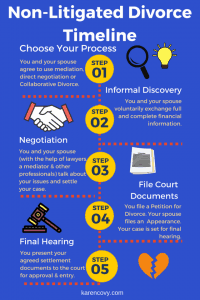Everything happens in its own time. But, when it comes to divorce, it seems like nothing happens on time or in time! It’s bad enough that getting a divorce is like having an ice-pick driven through your heart. But the way that divorces drag on and on makes the pain so much worse. You wish you could just set a divorce timeline that got you through your divorce in some kind of reasonable way!
The good news is, you can.
Once you understand how the divorce process works, you can start to manage your divorce timeline, as well as your own expectations. That way you will have a much better chance of keeping your divorce moving forward and your frustration level in check. While you still may not get divorced as fast as you want, managing your divorce timeline will help you have at least some control over your divorce process.
(Of course, your spouse, the attorneys, the judge, and life itself will also influence how long it takes for you to get a divorce, too.)
Here’s what you need to know to set your divorce timeline in a way that works.
 The Unfortunate Truth About Divorce
The Unfortunate Truth About Divorce
No one wants their divorce to take years.
The problem is, the divorce system moves about as quickly as a sloth on tranquilizers. Court dockets are crowded. Divorce lawyers are busy. Divorcing couples need time to work through their emotions and their issues.
For the most part, nothing in divorce happens fast.
What makes divorce seem to go even slower is that, if you’re like most people, you have no idea how the divorce process actually works. You don’t know what to expect, or what has to happen in the divorce process for you to get from where you are now, to where you want to be (i.e. divorced).
Needless to say, that doesn’t make trying to plan your already chaotic life any easier!
Understanding your divorce timeline, that is, the way your divorce case will proceed from start to finish, can help make your future a little clearer. (It can also dramatically reduce your frustration level!)
Your Divorce Timeline Depends on Your Divorce Process
The first thing you need to understand about your divorce timeline is that it depends a lot on which divorce process you have chosen to pursue.
If you are involved in litigation, your timeline will follow one path. (Most litigation timelines are notoriously slow! … Sorry!)
If you are using any of the alternative dispute resolution systems outside of litigation (i.e. mediation, collaborative divorce, or cooperative divorce) your timeline will be a bit different. It will also be faster.
 The Court System
The Court System
No matter what divorce process you use, ALL divorce cases must go through the court system at some point. The reason is simple: only a judge can divorce you.
Even still, the steps your divorce case will follow will differ depending upon whether you are actually fighting in court, or whether you have settled all of your issues and are only going to court for final approval of your agreement.
Finally, while the steps are similar in every court, they are not necessarily identical. Each divorce process may vary slightly, depending upon where you live and what your court system is like.
A Basic Divorce Timeline in Court
Your court process will start when you or your attorney files a Petition for Divorce. Depending on where you live, this document may be called a Petition for Dissolution of Marriage, a Petition for Divorce, or a Complaint for Divorce.
What is important to know is that, from the court’s perspective, your case does not begin until you file a document in court that essentially says, “Judge, I want a divorce.”
After you file your case you have to serve your spouse with a summons and a copy of the Petition/Complaint. If your spouse will voluntarily file an appearance with the court, then you can skip this step. (You don’t have to have your spouse served with papers if your spouse will voluntarily participate in the case.)
If your spouse is trying to dodge service, this step alone can take you weeks or months longer than it would take for most people.
If you and your spouse are no longer communicating and you don’t know where your spouse lives, this step can take even longer. You may have to publish notice of your case in a local legal newspaper for a certain amount of time. Then you have to wait to see whether your spouse shows up.
(PRO TIP: If you don’t know where your spouse lives, do yourself a favor. Hire a lawyer to handle this step for you.)
 The Litigated Divorce Timeline
The Litigated Divorce Timeline
After both you and your spouse are “in” the case, you enter the “discovery” phase of your divorce.
During this time, you and your spouse will exchange formal requests for documents and information about all issues in your divorce, especially about your finances. You or your spouse may issue subpoenas to banks, credit card companies, retirement account managers, etc., during discovery. You may also take depositions of each other or of other people during this time.
Depending upon the complexity of your case and where it is filed, discovery could last anywhere from a couple of months to a couple of years.
While discovery is going on the lawyers may file different motions asking the court to take action on some issue or another. You also may be ordered to attend mediation or get custody evaluations during this time.
Eventually, the court may hold a pre-trial conference in your case. During that conference your lawyers will informally present your case to the judge. The judge then usually makes recommendations about how s/he thinks you can settle your case.
If your case doesn’t settle, discovery will continue. At some point the judge will set your case for trial.
Your trial may take place on the first date it is scheduled. Or, it may get continued multiple times. (Continuances are fairly normal in the legal world, at least in some courts.)
Before any trial begins, the lawyers will likely try to settle your case again. If that doesn’t work, you will go through a full trial. A trial can take anywhere from a couple of hours to a couple of weeks, or more. The trial may also be conducted day after day until it ends. Or, it may take place in bits and pieces over the course of many months.
 The Non-Litigated Divorce Timeline
The Non-Litigated Divorce Timeline
If you are using the collaborative process, mediation, or any other type of alternative dispute resolution to resolve your divorce, your divorce timeline will be different from what is outlined above.
Your divorce will start once you and your spouse decide which divorce process to use. From there you will hire appropriate lawyers, a mediator, and other necessary professionals.
You may have one or more meetings to start your divorce off. You and your spouse will then have to exchange financial and other relevant information. Unlike in divorce litigation you will exchange this information informally. Typically that takes a lot less time than going through the court discovery process.
After that you will begin exploring your options and negotiating your case.
Once you and your spouse reach an agreement, your lawyers will write that agreement into a formal legal document. The document will likely bounce back and forth between you, your spouse and the lawyers several times before everyone is happy with it.
Once the agreement is finalized, either you, your lawyers, or both of you (again, depending upon your jurisdiction) will go to court, and get a divorce judgment entered.
Setting Your Divorce Timeline
Now that you generally understand the way the divorce process works, you can use that information to manage your own time and resources appropriately. You can also use it to reality-check your expectations.
As you can see, no matter what divorce process you choose, you are not going to get through your divorce in a week, or even a month. The divorce process takes time.
Similarly, if you need to untangle your finances, make new living arrangements, or help the kids to adjust to your divorce, all of that will take time. Emotionally adjusting to all the changes in your life will also take time.
(Remember, you are not a robot! You can’t expect to turn your entire life inside out in a matter of days and be okay with it.)
In my experience, the best and easiest way for you to control your divorce timeline is to stay out of court. Non-litigated divorces tend to take less time. They also keep the reigns of your divorce in your own hands.
Once you file your case in court, the judge controls your divorce timeline – not you!
Of course, no matter what divorce process you use, your spouse will also play a huge part in your divorce timeline. If your spouse is reasonable, there is a much better chance that your divorce timeline will be reasonable. If your spouse is unreasonable, well, fasten your seatbelt and get ready for a much longer ride! (Sorry!)
 Why Understanding Your Divorce Timeline Matters
Why Understanding Your Divorce Timeline Matters
Regardless of how much control you actually have (or don’t have!) over your divorce timeline, just knowing the steps in the timeline can help you get through your divorce more sanely. It can help you manage your expectations, as well as your expenses.
For example, trial is the most expensive part of any divorce. If you are litigating your divorce, and a trial date has been set in your case, your attorney must begin preparing for that trial. That’s going to cost you money.
If you know that on the front end, you may work harder to settle your case before you’re on the court house steps.
The more you understand the steps you are going to have to go through to get divorced, the more realistic you will be as you are going through the divorce process. While that may not make getting divorced any less painful, it just might make it a whole lot less frustrating.
_____________


 The Unfortunate Truth About Divorce
The Unfortunate Truth About Divorce  The Court System
The Court System The Litigated Divorce Timeline
The Litigated Divorce Timeline The Non-Litigated Divorce Timeline
The Non-Litigated Divorce Timeline Why Understanding Your Divorce Timeline Matters
Why Understanding Your Divorce Timeline Matters
Great article about understanding the timeline of divorce. I didn’t realize that there were so many different pathways of divorce. It makes sense, though, that different methods would take different amounts of time. Either way, I think it is good to know how long the process will take in your case and then realize that things can go slow. Thanks for explaining all of this!
You’re welcome!
Karen